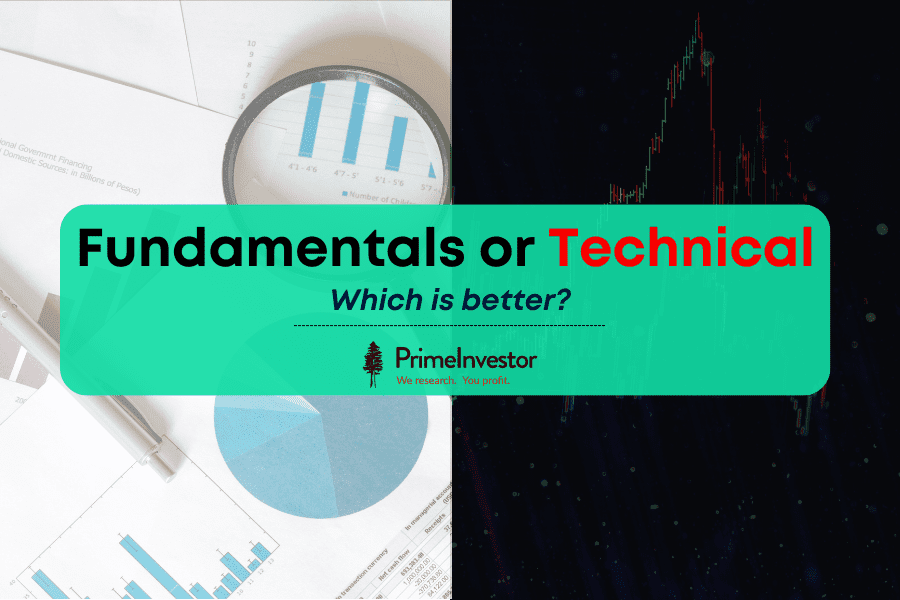There are more theories on what works in stock investing than there are listed stocks. Each one seems to be successful at some point in time. However, there is still no single universally applicable formula. I am still in search of that magic formula. If any of you do find one, please post it in the comments section.
But if there can be said to be two warring camps on the right approach to stock investing, these are usually fundamental analysis and technical analysis. Both have loyal camps of followers who swear that their method works best.

The fundamental approach
Fundamental analysis focuses on factors that go to influence the valuation and thus the price of a stock. Fundamental analysts use different tools to figure out the fair value of a company’s stock. This drives their buy and sell decisions. Sustainability of earnings and growth are two important facets of determination of fair value.
The factors can be company-specific or external environment related. We can list out as many factors as we like including management quality, competition, demand, supply, business strategy, profitability, leverage and so on. Based on this analysis, we arrive at two things – Net Asset Value (also known as Book Value) and Earnings.
All other factors are a subset of one of these. Our final valuation is dependent on Book Value or Earnings. Each one of us have our method of computing a ‘fair value’ for a stock and then plan our buy/sell decisions based on where the stock price is, relative to that fair value. Valuation is the outcome of this process. Yes, it is a subjective call, using relative valuation as well as some assumptions.
In other words, fundamental analysis of a company is intended to answer two big questions:
- Should one be buying a specific stock or not?
- What is the approximate price range at which it can be bought?
Extensions to this would be the time to hold or sell, growth expectations, the cues for periodic review etc. Every buy has a reason and so would a sell. Ideally, all this should be a part of the process you follow.
Fundamental analysis would also cover a part of what is commonly referred to as ‘macro’ analysis. To (over) simplify, we assume that if the economy is doing well, the stock markets will do well. If there is a problem with the economy, stock markets will not do well. Essentially, if you are handling a portfolio spread across multiple countries, you will invest more money in economies that will do well and less in economies that appear relatively weak.
As a domestic investor, I do not have to necessarily make this call. But I do tend to hold back or defer investment in equity itself, if there are some red lights flashing on the macro picture. What I am trying to do is to time the market. Since all my investments are based on prospective returns from the time I invest, I am happy to invest more when prices are down. This happens when there is an across-the-board weakness or some temporary issue with the company I have chosen.
Fundamental analysis by itself helps us to identify what businesses to buy (and also what to sell). We can use the fair value we estimate as a guide to whether a stock is a buy or a sell at a given point in time.
Of course, I never get tired of repeating that you must have a written process for buying and selling. DO NOT make exceptions to it, because you do not have it in you to absorb some losses. No analysis is fool-proof. Benjamin Graham is considered to be the gold standard in fundamental analysis, so if you are inclined to learn from scratch do read his seminal book: The Intelligent Investor.
Technical Analysis
To most people, Technical Analysis (TA) brings to mind stock price charts with price, volumes. You immediately picture colourful terminology that talks of ‘head and shoulder’ and ‘cup and handle’ patterns, statistical measures like 200-day moving averages, RSI Oscillators, Bollinger Bands and many tools. The thing I’ve observed about technical analysis is, either you are an ardent believer in it with a passion or you do not understand it at all or you are a non-believer.
I had a non-believer approach to technical analysis till around early 1994. I met with Saumil Trivedi who became my colleague, friend and philosopher as time progressed. He was a technical analyst and I started to work in tandem with him. He would be poring through charts and we had a combined approach. I had to give him a list of fundamentally good stocks.
He would track those closely and give his calls. He would also find out interesting charts and turn them over to me for my screening. He was much sought after by fund managers and his weekly calls on the broad indices were remarkably accurate. Very senior and renowned investment managers were his friends and sought his views quite regularly.
In essence technical analysis is a study of stock price movements using past price patterns, to extrapolate the likely future behaviour of stocks and act accordingly. Despite using similar inputs, specialists using technical analysis often interpret a price chart uniquely. It depends on their experience, method and the number of factors they look at. There are probably as many technical analysis theories as there are analysts. Essentially, they focus on price and give their view on up/down or neutral.
It is also said that technical analysis is not isolated. Price movements happen because of some impending event that is known to markets before it becomes public. Price movements are like the proverbial ‘smoking gun’. I do not understand technical analysis, but I do respect its practitioners. During my times with Saumil, he would be the one who would decide the timing of entry and exit on fundamentally identified stock picks. Professional fund managers would respect his views and time their buys/sells in consultation with him.
Technical analysis is an essential tool for traders who buy and sell for short term gains. They are focused on price and volatility rather than the long term potential of the underlying company. Any trading strategy you follow should ideally also have a ‘stop-loss’ mechanism. If you do not have one, you will end up with a basket of stocks that become ‘long term’ investments due to trades gone wrong.
If you are using technical analysis, do remember to follow your rules, never make exceptions and use stop-loss triggers. Do not rationalize falling prices.
My approach
I have an approach to investment that classifies companies into two buckets based on their Balance Sheet and Earnings.
The balance sheet approach is for those companies that are cyclical. Here technology is not a differentiator and most companies are like one another, except in scale. Here, what is relevant to me is the ‘cost’ or ‘book value’ with reference to price and so I use P/BV as my main measure. I like to wait for extreme pessimism and buy. I wait for the upturn to happen. I try and get out before the analysts start putting out P/E based buys to push these stocks. These are like trading opportunities and I could end up holding a stock for one to two years.
For companies in FMCG, IT, pharma and so on, I like to use earnings as my guide and here the ROE, P/E, price to growth are the yardstick. Here I use the ROE and P/E bands to get in and out. As regards NBFCs and banks, I prefer to look at history, management, ROE and Price to Book.
The technicals I use
As a fundamental investor myself, I have created a component that I label as ‘technicals’ of a stock. Before I buy or sell a stock, I generally like to look at a host of factors which help me in position-sizing as well as timing my buys or sells.
- A P/E (price to earnings) band and a P/BV (price to book value) band for the past ten years is useful. This tells me the valuation range of a stock/index. A simple high/low of the price, does not convey value because a low price may never come again because a company is growing with time and its earnings are also growing. If I take the ten-year adjusted price of Reliance, it has a low of Rs.380 and a high of Rs.2780. It would be foolish of me to even imagine that I will wait for a price closer to 380 to buy the stock.
However, if I map the P/E high and low during that period and find that it is between say 15 and 30 times, I can now decide to buy it when the PE drops closer to 15, so that I have a better upside potential. Similarly, I can use the P/BV band of a banking stock to buy it close to its historically low P/BV. - The other thing I like to understand is liquidity. This is a problem with most mid-caps and small-caps. Often, they are very easy to buy. When you go to sell, you find a huge price drop even with a very small volume. In a bull market, often the promoter / operators provide the liquidity for buying. When selling comes, the bottom sometimes falls out.
- Shareholding pattern and number of shareholders. Helps to understand how easy or difficult an exit would be
- Percentage of delivery-backed volumes out of total traded volumes
- In the past, one could often identify which broker/s is the (unofficial) ‘market-maker’ in a stock. Based on the deep pockets or otherwise of the backer, this helped one decide whether to buy a stock or not. Today, the network is quite wide and can include celebrity investors or broker funding, so the ‘market maker’ is more difficult to determine. Social media is also an active weapon for stock price manipulation, which makes it all the more difficult to judge small companies.
To sum up
For creating a long-term portfolio, fundamental analysis is the essential approach. But you can use technical analysis to support your buy-sell decisions. Document your process for buying and selling. Do not ever violate your process by making exceptions. Try and keep your emotions out.
Apart from this, there is another approach called ‘Quant’ that is quite popular today. Here based on stocks meeting certain qualifications, we can create a portfolio.
To give you a very simple example, I can create a portfolio of the ten stocks with the highest market cap, using the criteria of ROE more than 25% and market cap more than Rs.20,000 crore. Every month end, I review and change the basket by looking at the ranks again. Most of these ‘quant’ approaches are decided after rigorous ‘back-testing’. You can have very exotic baskets by adding to the number and variety of screeners you use.
Each day, someone in the markets will come up with a ‘new’ and ‘failsafe’ approach to winning in the stock market. But we still have to find that Holy Grail. Until we find that, our only way to protect against capital loss is through diversification and position sizing. In other words, there’s no substitute for prudent risk management.






9 thoughts on “Fundamental analysis or technical analysis: which is better?”
Pls help me understand about cycle business and non-cycle business.
Cyclical is a one where there are natural ups and downs in the industry. Metals, sugar, chemicals, banking, capital goods, infra are all cyclical. Those that have less such ups and downs like FMCG, consumer, and to some extent IT are non-cyclical.
Very well articulated by Bala. Technical Analysis can at best be a supporter of Fundamental Analysis, cannot become the primary tool for investing. Today many social media “Experts” who conduct online courses at a stiff fee educate their gullible students with their hypothesis that TA is the be all and end all of Investing and FA is irrelevant.
Thanks for acknowledging the merits of technical analysis too.. Its the language that the markets speak and is very rewarding to learn and deploy.
very well said. in my opinion fundamental screening should always precede technical analysis because in the long run wealth creation is attributable to buying equity of profitable and growing businesses.
Hi Sir, Thank you for the insightful article as always.
Can you suggest some platform to get the 10 year P/E and P/B values of stocks.
It would have to be some paid site. I use Pixstox. Bloomberg gives you.
Hello Balakrishnan Sir,
Very good article. You mentioned portfolio of 10 stocks you are maintaining based on market cap. Don’t you feel it very concentrated portfolio? In fact I’ll love to have portfolio of less than 20 stocks. But I have a fear of missing some good companies .
I am referring to a QUANT strategy, which is blind to names. It only focuses on quantitative criterion
Comments are closed.